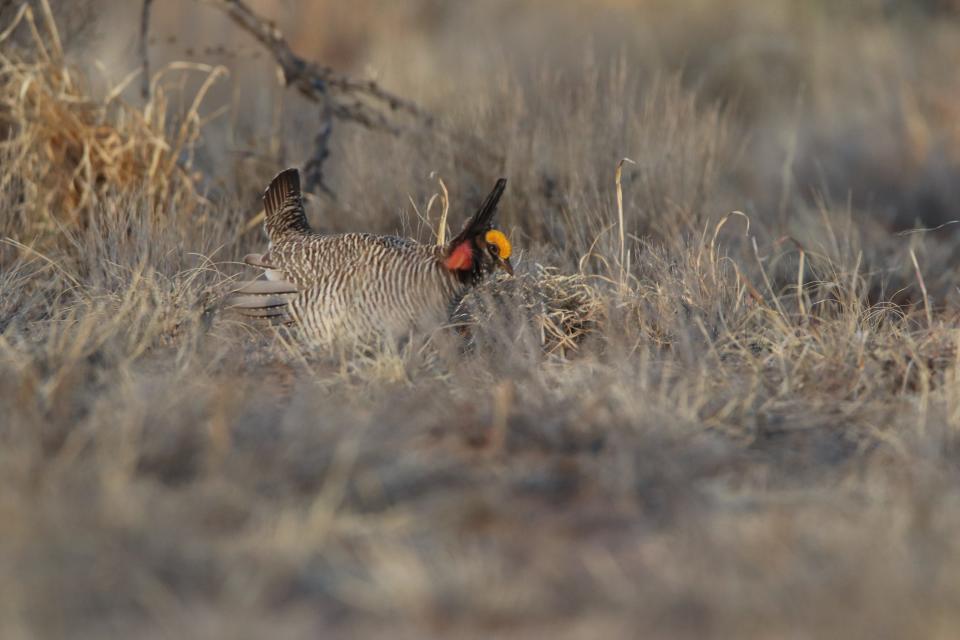Lesser prairie chicken numbers dwindle as federal protections take effect this month
A bird iconic to the American West continued to see its numbers dwindle last year as federal protections for the species were weeks away from going into effect.
The lesser prairie chicken was deemed “endangered” in New Mexico by the U.S. Fish and Wildlife Service last November, meaning the strongest federal restrictions on development in known chicken habitat areas would be imposed.
An endangered status also requires the agency to list lands as “critical habitat” where the species survives and could potentially expand into.
More:Lesser prairie chicken now an endangered species in New Mexico amid industry anxieties
The Fish and Wildlife Service divided the chicken population into two areas: a northern distinct population segment (DPS) covering parts of Colorado, Texas, Oklahoma and Kansas and a southern DPS known as the “shinnery oak prairie” in eastern New Mexico and West Texas.
The southern DPS was listed as endangered, while the northern DPS was given “threatened” status, meaning conditions could soon warrant an endangered listing.
The listing goes into effect Jan. 24, and amid continual declines in lesser prairie chicken populations, threatened by development in the areas where it dwells and continual aridification tied to pollution and subsequent climate change.
More:Oil and gas, earthquakes top southern New Mexico environmental stories in 2022

A recent study released by the Western Association of Fish and Wildlife Agencies (WAFWA) showed prairie chicken numbers steadily declined, with 510 birds remaining in the shinnery oak region in 2022.
That’s a decline of about 1,000 birds from last year’s total of 1,569, records show, which marked a drop of more than 3,000 birds from a population of 4,881 reported in 2020 and 5,012 reported in 2018, according to the WAFWA report.
Before 2018, WAFWA did report years of growth in prairie chicken numbers in the region, from 701 birds reported in 2015 to 2,808 in 2016.
More:New Mexico could play role in saving jaguars from extinction, petition says
But that number began to fall in the year following to 2,050 in 2017 before more than doubling in the following year.
From 2012 to 2014, the prairie chicken in the shinnery oak prairie region fell from 2,967 to 1,155.
Range-wide, WAFWA estimated there to be 26,591 birds in 2022, falling from 33,504 last year, and an overall decline from 30,682 the Association counted in 2012.
More:Restrictions on coyote killings in New Mexico could protect endangered lobos, petition says
Even upward fluctuations through the years were not adequate to determine success in past conservation efforts for an animal that once numbered in the hundreds of thousands said Wayne Walker, president of conservation bank LPC Conservation.
“It’s not working,” he said of past efforts. “New Mexico has thrown more at this than any other state. It’s not just not working here, it’s not working anywhere. Until ranchers can get a market-based rate for conservation, it’s not going to work.
“You’re like a hailstorm or some big weather event away from an entire population dying out.”
More:Lawsuit to protect minnow imperiled in Pecos River, Rio Grande of southern New Mexico
LPC Conservation seeks out suitable habitat for the bird’s recovery and then pays landowners a “market value,” Walker said, for the land by selling conservation credits.
Landowners also receive legal assurances through the transactions to avoid any government action relate to the species.
This privatized method of conserving the lesser prairie chicken, Walker said, was ideal in the face of what he called a failure so far of government conservation programs to see a meaningful rebuild of the species.
More:Oil and gas land sale in New Mexico protested by environmentalists alleging pollution harm
“We’ve got to get these programs working more strategically, paying rates and at a larger scale,” Walker said. “New Mexico is endangered. That’s not a success.”
Carlsbad-area nonprofit the Center for Excellence (CEHMM) works directly with government agencies on conservation efforts for the chicken and several other species in the region, providing candidate conservation agreements (CCAs) on state, federal and private lands that see landowners enacting certain conservation practices in order to avoid restriction imposed by listings.
CEHMM’s latest report for the third quarter of last year, July to September 2022, showed about 1.2 million acres or 55.7 percent of the chicken's estimated occupied range in New Mexico was enrolled in CEHMM’s programs.
More:Lawsuit chides 'inaction' in saving rare bird threatened by oil and gas in Permian Basin
In a statement announcing the listing, Amy Lueders, Fish and Wildlife Service southwest regional director said voluntary conservation agreements were crucial to the survival of the bird, while allowing industry in the area to continue providing economic support.
“The Service continues to work with stakeholders to develop voluntary conservation agreements that will protect the lesser prairie-chicken and the native grasslands on which it depends while assuring that oil and gas and renewable energy development, ranching, agriculture and other activities continue,” she said.
Walker said the lesser prairie chicken was an indicator as to the health of the prairie lands needed by the bird, which were also essential for several other species including humans.
“We need this ecosystem to produce water, food,” he said. “If we don’t turn this bird around, the ecosystem is going to degrade.”
Adrian Hedden can be reached at 575-628-5516, achedden@currentargus.com or @AdrianHedden on Twitter.
This article originally appeared on Carlsbad Current-Argus: Lesser prairie chicken numbers dwindle as federal protections loom

